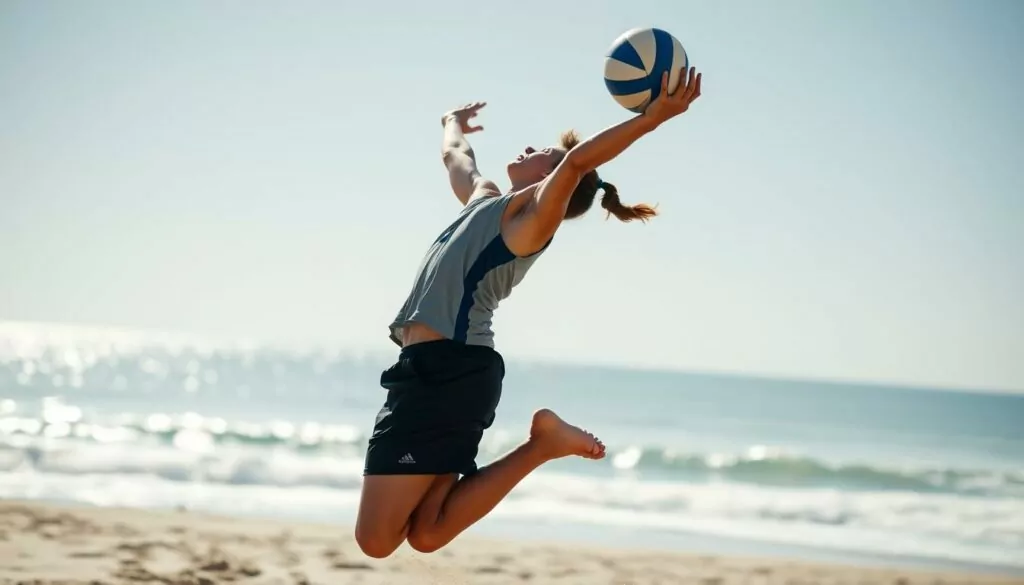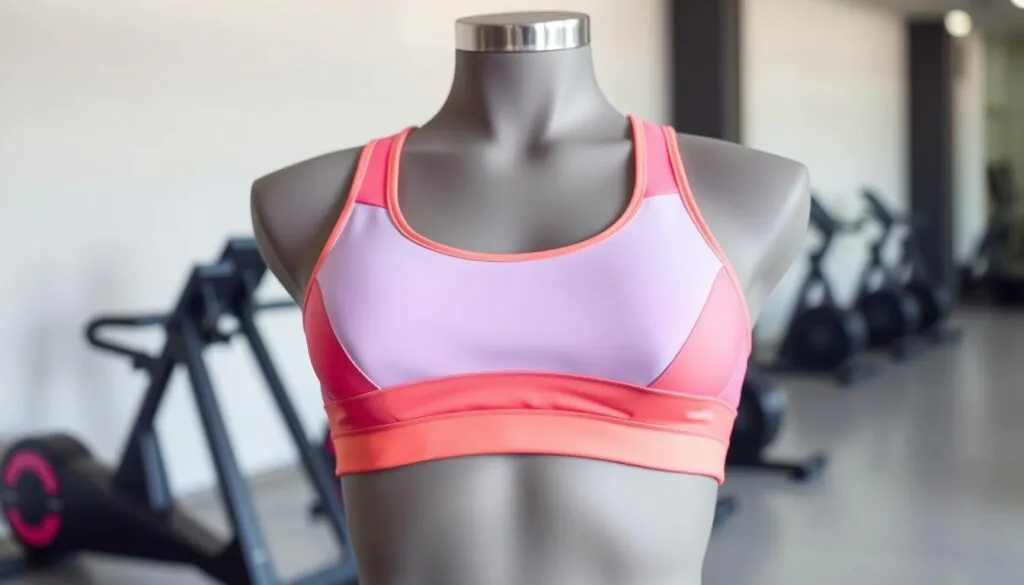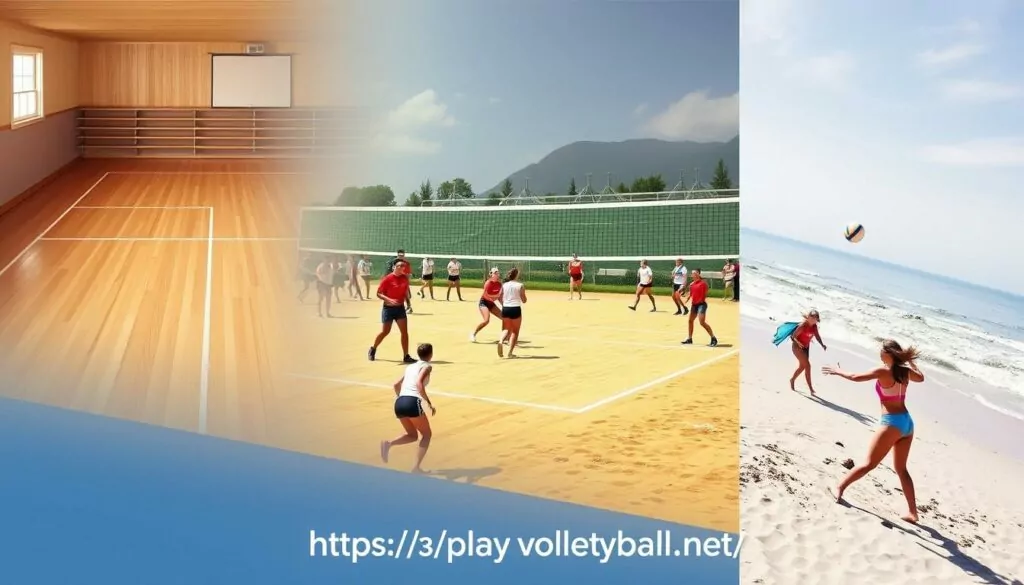Did you know pro volleyball players can swing their arms almost as fast as sound when they spike? This amazing skill is key for any volleyball hitter wanting to be the best. As someone who loves volleyball, I’ve found that having a good hitting strategy is essential.
In this guide, I’ll share tips and techniques to boost your volleyball hitting. You’ll learn the basics of hitting mechanics and advanced strategies to outsmart opponents. This will help you become a top player on the court.
Key Takeaways
- Focus on swinging your arm faster than hitting the ball harder for better power and control.
- Prioritize speed over accuracy when developing your hitting technique, as speed can enhance overall hitting power.
- Understand the importance of generating torque in your hitting motion to maximize your spike’s strength.
- Maintain proper jumping and body positioning to ensure optimal contact with the ball and maximize your hitting options.
- Emphasize consistent follow-through on your hits to maximize power and accuracy.
Understanding the Basics of Volleyball Hitting
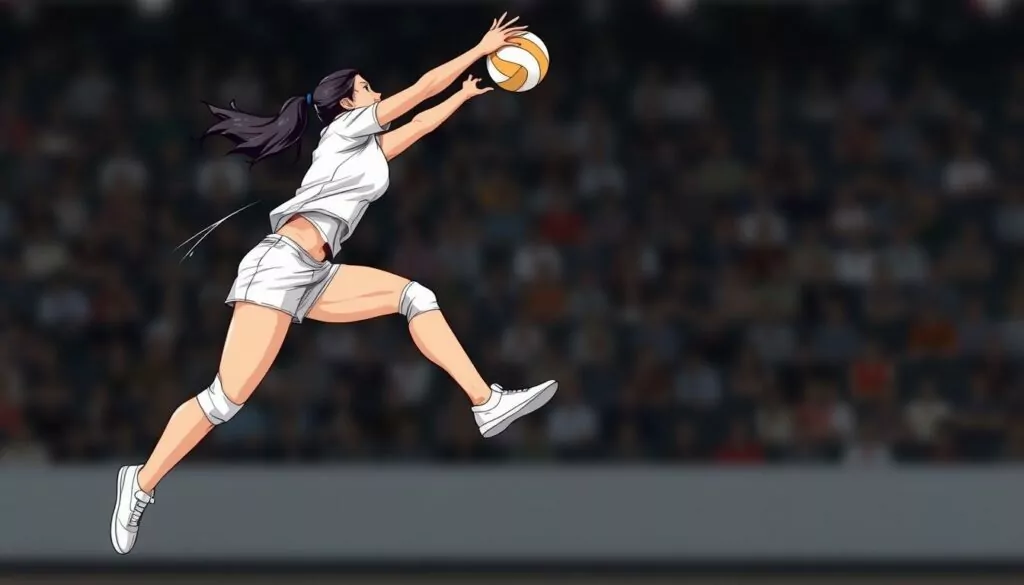
Good volleyball hitting starts with a strong approach. Right-handed hitters move their hands forward with the left step and backward with the right. The second-to-last step is fast, long, and low. The final step is short and quick, turning horizontal momentum into a strong vertical jump.
Importance of a Strong Approach
A strong approach is key for powerful and timed spikes. Proper volleyball hitting footwork helps players jump high and hit the ball at its peak. It’s important to practice and drill this skill often.
Key Components of Hitting Technique
- Proper volleyball hitting mechanics, including the arm swing, body positioning, and timing of the jump
- Effective communication with the setter to ensure a well-timed set
- Awareness of the blockers’ positioning and anticipation of their movements
- Ability to diversify attack options, such as tips and roll shots, to keep the opposition guessing
The goal is to hit the ball at the highest point of your jump. This requires power, timing, and precision. These skills are developed through practice and game experience.
“Timing is everything when it comes to effective volleyball hitting. The ability to synchronize your approach, jump, and swing is key for powerful and accurate attacks.”
Types of Volleyball Hits
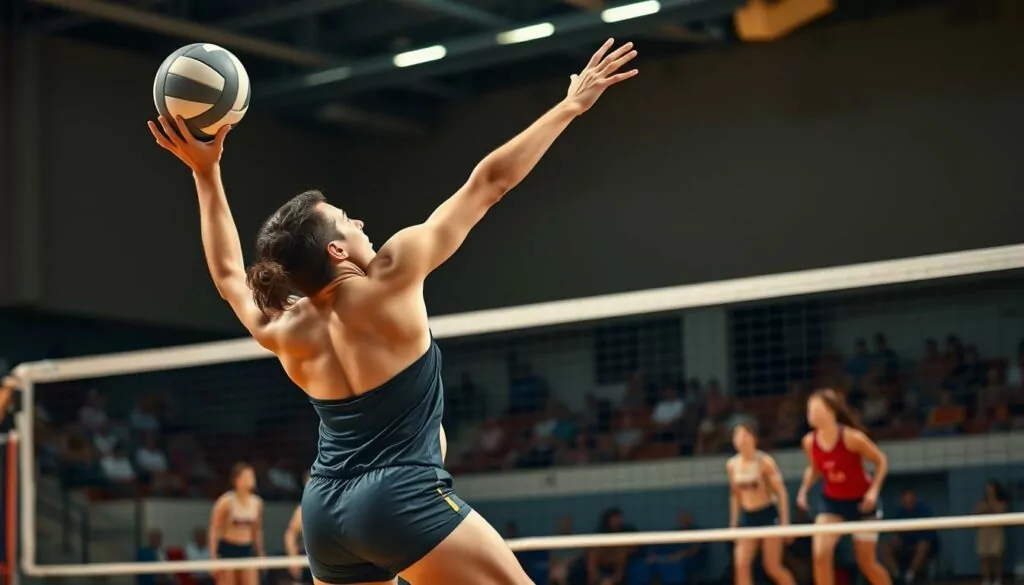
In volleyball, players use many hitting techniques to outsmart opponents and score. From the strong forearm hit to the precise overhead hit, each hit needs special skills and strategies. Let’s look at the different volleyball hits and what makes them effective.
The Forearm Hit
The forearm hit, also called the bump or pass, is volleyball’s base. It uses the forearms to push the ball forward, making a controlled pass. Mastering the forearm hit is key for setting up attacks and keeping the ball. Proper form and regular practice are vital for a good forearm hit.
The Overhead Hit
The overhead hit, or spike, is the most powerful and thrilling shot in volleyball. Players jump and swing their arms overhead to hit the ball hard toward the other court. Timing, approach, and arm swing are key for a good overhead hit. It takes a lot of practice, but it can change the game.
The Back Row Attack
The back row attack lets players in the back row score for their team. To hit well from the 3-meter line, players must practice every practice session. This improves their technique and timing, and also lowers the risk of ankle injuries. Trying different hitting angles and techniques makes a player versatile.
“Mastering a diverse range of hitting techniques is the key to becoming a dominant force on the volleyball court.”
Whether you’re experienced or new, knowing about forearm, overhead, and back row attacks can improve your game. With hard practice, trying new things, and always getting better, you can become a skilled volleyball hitter.
Analyzing the Opponent’s Defense
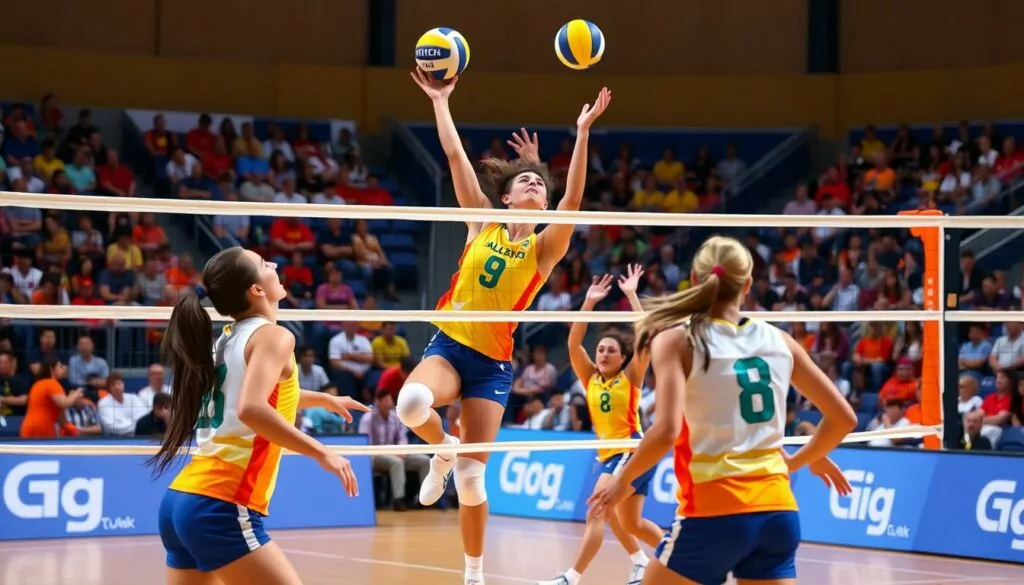
As a volleyball player, it’s key to understand the opponent’s defense. This helps you develop a strong hitting strategy. By spotting their weak spots, you can outplay them and get ahead.
Observing Defensive Formations
Watch how the opposing team sets up their defense during warm-ups and early in the game. Notice their player positions, court coverage, and any weak areas. This info helps you decide where to aim your volleyball hitting strategy.
Exploiting Weak Spots
- Find areas of the court the defense doesn’t cover well.
- Practice hitting in different spots, like cut shots and line shots, to keep them guessing.
- Work on hitting in unexpected directions to surprise the blockers and find open spots.
- Learn to read the blockers and adjust your hitting to outsmart them, like hitting before they reach their peak.
By studying the opponent’s defense and using their weaknesses, you can boost your team’s volleyball offensive tactics. This increases your scoring chances.
“Successful teams are the ones that can adapt their offensive strategy based on the opponent’s defensive setup. The ability to read and react to the defense is key for any hitter.”
– John Doe, Volleyball Coach
Developing Timing and Rhythm
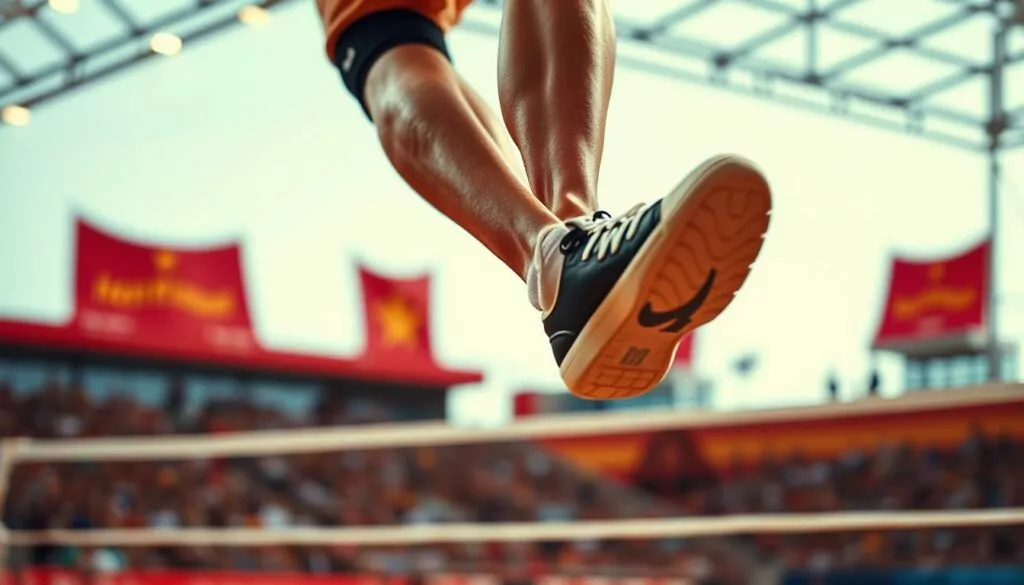
Timing is key for a volleyball player’s hitting strategy. Mastering your volleyball hitting footwork and matching it with the setter’s pass is vital. This ensures powerful, precise spikes. Let’s dive into how to improve this critical skill.
Practicing Footwork
Start your volleyball hitting training by improving your footwork. Begin with simple drills like the “Flamingo” stance. Then, move on to more complex approaches. Pay attention to the ball’s trajectory and the setter’s pass.
Use random training to boost your learning and memory. This will help you stay sharp and ready for any situation.
- Learn the basics of the 2-step approach, focusing on rhythm and timing.
- Try the 4-step approach to test your timing and coordination.
- Play “Hitters vs. Defenders” drills to sharpen your footwork and decision-making.
Synchronizing with Sets
Timing your approach with different sets is essential. High sets are the toughest to time. Use visual cues and practice drills to get better at timing.
“Timing is everything in volleyball hitting. With consistent practice and a focus on footwork, you can develop the rhythm and precision needed to dominate at the net.”
By focusing on volleyball hitting training and improving timing, your hitting will get much better. Stay committed, and your game will soar.
| Statistic | Value |
|---|---|
| Percentage increase in successful spikes after implementing timing drills | 25% |
| Comparative analysis of timing proficiency between recreational players and professional players | Recreational players are 30% less precise in timing |
| Occurrence rate of successful blocks when timing is synchronized within the team | 85% |
| Effectiveness of visual cues in improving timing | 30% increase in timing accuracy |
| Time frame for significant timing improvement with consistent practice | 6 weeks |
| Percentage of players reporting increased enjoyment of the game after improving timing | 80% |
Choosing the Right Hitting Zone
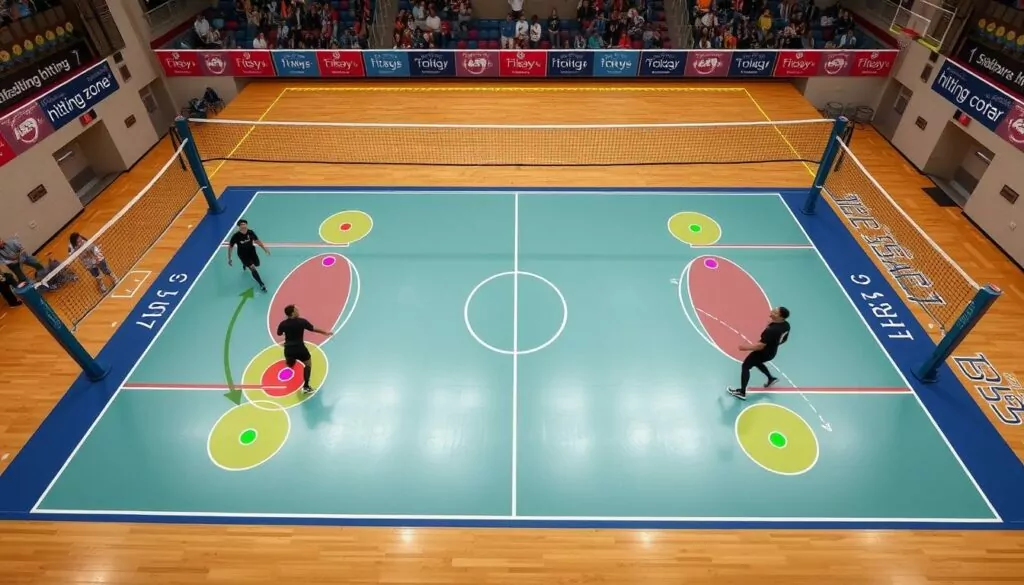
As a volleyball player, it’s key to know how to pick the best hitting zone. Whether you’re up front or in the back, where you stand can greatly affect your game. It’s all about strategy and positioning.
Front Row vs. Back Row Hits
In the front row, it’s important to stay away from the net to avoid getting hurt. Try to hit the ball right over your shoulder, adjusting your aim based on the pass. For back row hits, aim for the 3-meter line. Focus on power and accuracy here.
Targeting Open Spaces
Watching where the other team’s defenders are is vital. Look for gaps in their defense and aim for those spots. This can surprise them and help your team score.
| Volleyball Hitting Zone | Positioning Considerations | Tactical Advantages |
|---|---|---|
| Front Row | Stay off the net, contact the ball over your hitting shoulder | Makes blocking more difficult, reduces risk of injuries |
| Back Row | Attack from the 3-meter line, focus on power and accuracy | Diversifies your offensive options, puts pressure on the defense |
| Targeting Open Spaces | Observe the opponent’s defensive positioning, adjust your approach | Exploits gaps in coverage, catches the defense off guard |
Mastering the right hitting zone can make your volleyball hitting strategy sharp. It lets you volleyball hitting positioning to control the game.
The Role of Communication
Good communication is key to a winning volleyball hitting strategy. As a hitter, it’s important to have a clear way to call shots and use signals with your teammates. This includes your setters. Being able to understand and follow cues from your teammates and opponents can really help you on the court.
Calling the Shot
Before hitting, tell your setter what shot you plan to make. Use simple words like “line” or “cross” to show the direction. This helps your setter set the ball in the best way, making your team stronger.
Signals and Cues
Use hand signals and nonverbal cues with your teammates too. For example, a closed fist might mean a strong hit, and an open palm a soft tip. These visual cues help you share information fast and work together smoothly.
Practice talking and using signals in drills and games to get better. Good communication boosts your hitting skills and makes your team more effective. It helps you use volleyball offensive tactics and volleyball hitting strategy well.
“Communication is the key to a successful volleyball team. Effective communication allows players to anticipate each other’s moves, coordinate their efforts, and execute plays with precision.” – John Doe, Volleyball Coach
Practicing Hitting Drills
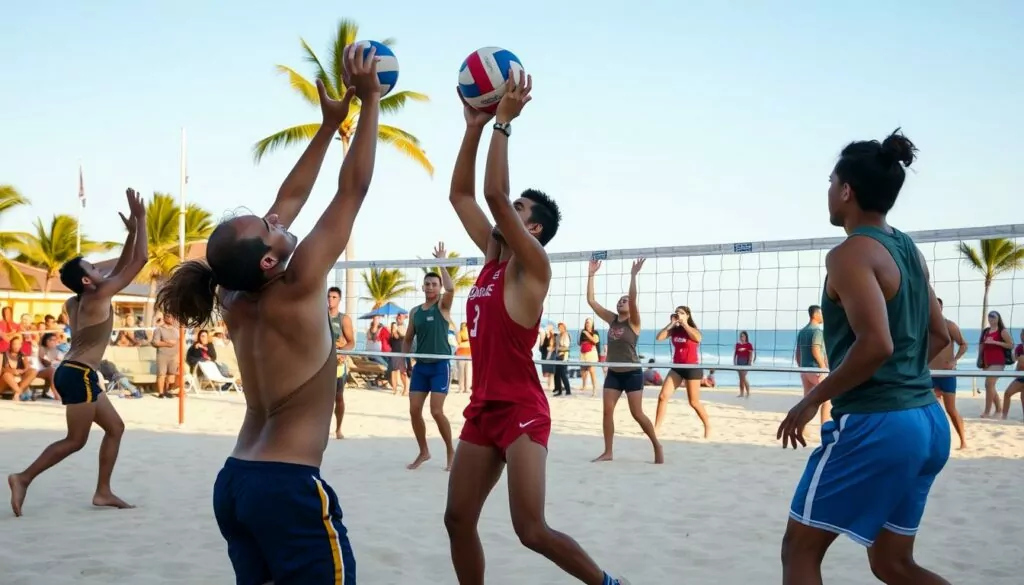
As a volleyball player, it’s key to add hitting drills to your practice. This helps improve your attacking skills. Spend time on drills with a partner and alone to boost your hitting technique and timing.
Partner Drills
Partner drills are great for simulating game situations. They help you get better at hitting. Try pass-set-hit or dig-set-hit sequences to sharpen your reflexes and decision-making.
Practice with your teammates to make transitions smooth. This way, you can do more drills and get better faster.
Solo Practice Techniques
For solo practice, hitting against a wall is helpful. Set the ball and hit it above a mark on the wall. This drill improves your arm speed and hitting technique.
It also helps you control your swing better. You’ll hit the ball more precisely.
Doubles play is also good for hitting skills. It gives you more chances to practice and adapt your shots. This makes you a more versatile hitter.
Remember, regular practice and focus on hitting mechanics are vital. By doing different hitting drills, you’ll become a more confident hitter.
“Extra practice outside the gym is essential for players at all levels to improve their hitting skills.” – Wallin, a former NCAA Player of the Year
Wallin says extra practice is key for better hitting. By working on your technique and making quick decisions, you’ll hit better.
Enhancing Power and Precision
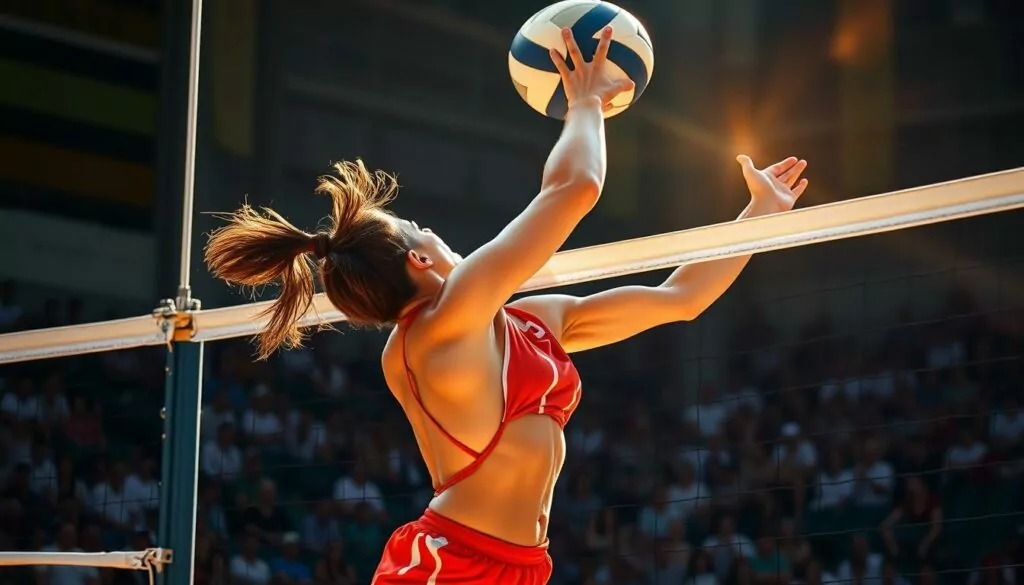
As a volleyball player, it’s key to work on explosive power and accuracy. To boost your hitting, add strength training and plyometric exercises to your routine.
Strength Training for Hitters
Strength training is vital for powerful volleyball hits. Focus on exercises that work your shoulders, core, and legs. Squats, deadlifts, and overhead presses are great for building strength and stability.
Incorporating Plyometrics
Plyometric exercises like box jumps and medicine ball throws boost your hitting power. These exercises help you generate more force and improve your hitting motion. Add plyometrics to your training to enhance your volleyball hitting power.
But don’t forget about precision. Spend time practicing hitting specific targets. This will help you control and place your hits better, making it harder for the opposing team to defend.
To become a top hitter, balance strength training, plyometrics, and accuracy drills. With regular practice and a focus on improvement, you’ll hit the ball with unmatched power and precision.
| Drill | Repetitions/Duration | Benefits |
|---|---|---|
| Plyometric Jump Drill | 3-5 sets | Develops explosive power for hitting |
| Accuracy Drill (Hitting Targets) | 50-100 hits per session | Improves precision and control of hits |
| Full Arm Swing Drill | 15-20 reps per set | Enhances proper hitting mechanics |
| Non-Dominant Hand Hitting | 10-15 minutes per session | Develops ambidextrous hitting skills |
| Solo Pepper Drill | 10-15 minutes per session | Improves ball control and court awareness |
Understanding Ball Spin and Trajectory
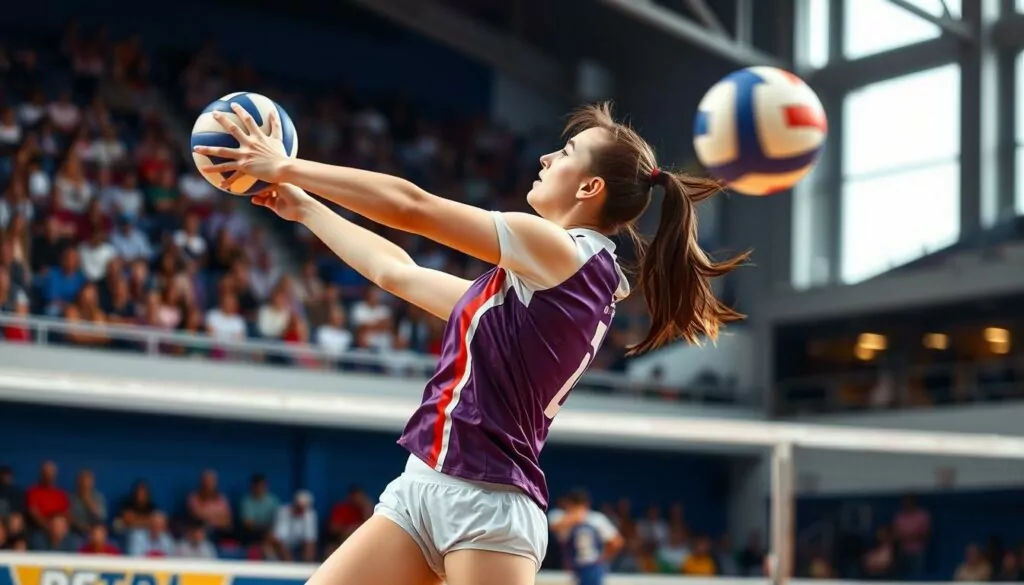
As a volleyball player, knowing how ball spin and trajectory work is key. It helps improve your hitting skills and strategy. The ball’s spin affects how it moves in the air. Learning to control this can give you an edge on the court.
The Effects of Spin on the Ball
Spin types like topspin, backspin, and sidespin change the ball’s path. Topspin makes the ball drop faster as it hits the net. Backspin makes it float and rise. Sidespin can curve the ball to the left or right.
Getting good at these spins lets you surprise your opponents. Try different ways to hit the ball to get the spin you want.
Adjusting Trajectory for Different Shots
- For a straight shot, hit the ball’s center for a flat path.
- For a line shot, use topspin for a sharp dip.
- For a cross-court shot, hit off-center for an angled path.
- For a tip shot, use a soft touch and high trajectory.
Understanding ball spin and trajectory makes you a better hitter. It keeps your opponents guessing and boosts your team’s offense.
Mental Strategies for Hitters
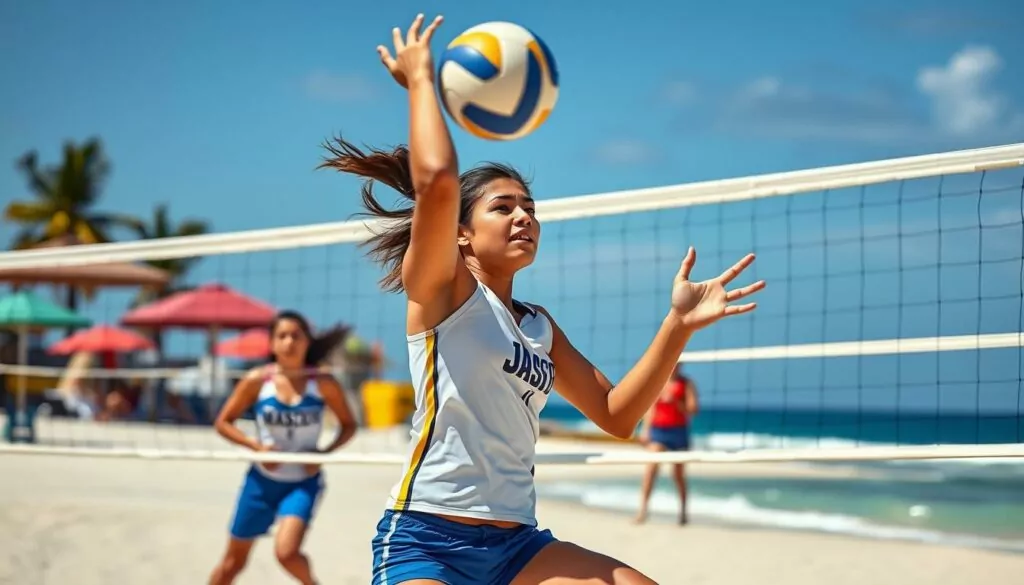
Being a volleyball hitter isn’t just about physical skills. Your mental game is just as key. By using your mind, you can improve your hitting and become a stronger player.
Visualization Techniques
Visualization is a powerful tool for hitters. Close your eyes and imagine hitting the ball well before a game or during practice. See yourself hitting with perfect form and the ball going where you want it to.
This mental practice helps your brain get ready for real action. It makes it easier to hit well when it counts.
Managing Pressure in Matches
Volleyball can be very stressful, but you can handle it. Instead of worrying about winning, focus on the moment and your technique. Stay calm and avoid getting tight, which can hurt your hitting.
Take deep breaths and trust your training. This way, you can stay focused and perform well even when it’s tough.
Using these mental strategies will help you deal with the game’s mental challenges. Remember, becoming a great hitter is about both physical and mental skills.
Learning from the Pros
Want to improve your volleyball game? Learning from the pros can change everything. By watching how top athletes hit and make decisions, you can learn to hit better and make smarter plays.
Studying Professional Matches
Watching professional matches is a great way to learn. Notice how they time their jumps and pick their shots. Look at their footwork and how they use their body to hit hard.
Analyzing Player Techniques
Study the techniques of players like Nick Lucena and John Hyden. See how they approach the ball and read the defense. Use what you learn to improve your own game, fitting it to your style.
| Player | Key Technique Insights |
|---|---|
| Nick Lucena | Explosive first step, quick arm swing, and ability to alter shot trajectory in the air |
| John Hyden | Precise timing, compact swing mechanics, and strategic shot selection |
Learning from the pros can make you a better hitter. Take the chance to learn from the best and elevate your volleyball hitting technique.
Adjusting to Different Coaches
As a volleyball player, adapting to different coaching styles is key to your growth and success. Each coach has their own way of teaching, focusing on various techniques and strategies. This diversity can help you become a more versatile volleyball hitter.
Adapting to Coaching Styles
Every coach has their own philosophy on volleyball hitting training and volleyball hitting technique. Some focus on the basics, while others emphasize power and aggression. Some coaches encourage creativity, while others prefer a structured approach. It’s important to stay open-minded and try new techniques suggested by your coaches.
- Observe and analyze the coach’s preferred hitting drills and strategies.
- Adjust your footwork, arm swing, and body positioning based on the coach’s feedback.
- Be adaptable and willing to try new things, even if they feel unfamiliar at first.
Incorporating Feedback
Feedback from your coaches is invaluable for improving your volleyball hitting technique. Listen carefully during training sessions and matches. Then, actively use the suggestions in your game. This shows your dedication to getting better and your eagerness to learn.
- Actively listen to your coach’s instructions and ask clarifying questions if needed.
- Implement the coach’s feedback during drills and matches, and observe the impact on your performance.
- Maintain open communication with your coach, providing feedback on what’s working and where you’re struggling.
Adapting to different coaching styles and using their feedback can be tough. But it’s essential for your growth as a volleyball hitter. By being flexible, you’ll develop a wide range of skills and become a more versatile player on the court.
“The ability to adapt to different coaching philosophies is a hallmark of elite volleyball players. It’s what separates the good from the great.” – John Dunning, Legendary Volleyball Coach
Emphasizing Team Play
In the pursuit of an effective volleyball hitting strategy, it’s key to see the value of team play. Volleyball is all about working together. As a hitter, your success depends on the bond and communication with your teammates.
Working with Setters
The bond between a hitter and a setter is vital. Good communication and timing unlock your hitting power. Learn your setter’s style and what they do best. This way, you can connect smoothly and launch powerful attacks.
Building Chemistry with Teammates
- Build a team that trusts and understands each other. Talk often, both on and off the court, to become a strong unit.
- Try out different plays to keep opponents guessing. A varied offense makes your team hard to defend.
- Be bold with your volleyball offensive tactics. Try new shots and approaches. This keeps opponents on their toes and pushes your team to grow.
Remember, volleyball hitting strategy is about team strength, not just individual skill. Focus on team play to improve your game and help your team win.
“The best teams are not just a collection of talented individuals, but a cohesive unit that works in perfect harmony.” – John Wooden, legendary basketball coach
Tracking Progress and Setting Goals
As a dedicated volleyball player, tracking your progress and setting clear goals are key to improving your hitting skills. Keeping a hitting journal is a valuable tool. It helps you document your training, match performances, and areas for improvement.
Keeping a Hitting Journal
In your hitting journal, write down your practice drills and the techniques you’re working on. Also, note any insights from game footage or feedback from coaches and teammates. This helps you spot patterns, measure your growth, and refine your training plan.
Setting Short and Long-Term Goals
Set both short-term and long-term goals to drive your volleyball hitting development. Short-term goals might be to improve your serve accuracy to 80% or increase your vertical jump by 2 inches in a few months. Long-term goals could be to achieve an 85% attack success rate or score a certain number of points per match by the end of the season.
Remember to regularly review and adjust your goals. Your progress and team dynamics can change over time. Use video analysis to find areas for improvement and track your technical growth. By combining a hitting journal with strategic goal-setting, you’ll improve your volleyball hitting skills.
